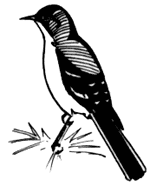Rock Wren:
Usually a common denizen of the talus slopes, disintegrating outcrops, and other similar areas where its energetic, distinctive trills blend into a unique pattern of sound with the acute whistle of the marmot and plaintive cry of the coney, the Rock Wren has been conspicuously absent during the summer of 1948. Not a single record has been reported from the entire park. In no previous year in which records have been kept has there been this complete absence of the species.
Townsend’s Solitaire:
Although this inauspicious songster has little in its doleful, ashy plumage to suggest its true familial affiliation, an instant of its heterogeneously rich song immediately identifies it with the other thrushes. The sight of this inconspicuous thrush with its white outer tail feathers and buffy wing spots, as it flutters gracefully to the ground to obtain an insect and returns to perch is not frequent in Crater Lake National Park. More frequently the male is to be seen, and heard, from the apex of a bare stub, often a hundred feet from the ground. It is almost paradoxical that the occupant of so lofty a song perch should nest on the ground; but such is almost invariably the case. On July 1, 1948, a nest with four downy young was found in an unprotected place on the ground on the west bank of Sand Creek. Only a single parent was observed to be caring for the young. This appears to be the first recorded observation of the nesting of this species in the park.
Short-tailed Chickadee:
Chickadees are the abundant acrobatic light percussioneers of the evergreen symphony. In autumn particularly, their unmusical vocalizations are warmly welcome to the ears of the ornithologists for they frequently constitute the nucleus of conglomerate flocks of Juncos, Chickadees, Chipping Sparrows, Warblers, and other species which wander through the coniferous forests during this season. Despite the ubiquity and abundance of these clamorous tits, our knowledge of the nesting habits of this species in Crater Lake National Park is amazingly sparse. During the course of the summer of 1948 three nests have been observed. On July 7 a pair was noted to be attending a nest in the utility building in the lower residential area at Park Headquarters. By July 12 food was being carried to the nest by both parents, indicating that young were being fed rather than food being carried to an incubating adult. On July 26 a nest was discovered in a dead Mountain Hemlock near the stone quarry; both parents were carrying food. On July 22 a nest was found in a dead Lodgepole Pine at the Junction of the Red Cone Motorway with the North Entrance Highway. These observations, and those of previous years, would indicate that nesting by this species in Crater Lake National Park must being in mid-June.
Slender-billed Nuthatch:
The insect and larva eating habits of this species and its more abundant and boisterous smaller relative, the Red-breasted Nuthatch, are of profound significance in the ecology of our coniferous forests. Together with certain of the Woodpeckers, the Chickadees, and the Creepers, the Nuthatches persistently depredate the populations of insects which frequent the barks of trees. Together with certain parasitic wasps and fungi these birds constitute the only natural control of many species of destructive insects. Prior to 1948 the Slender-billed Nuthatch had been regarded as a rare species of the higher altitudes whose breeding status was unknown. On July 12, 1948 a pair was found carrying food to a nest near the junction of the Crater Peak Motorway and the Rim Drive. Unlike the smaller Red-breasted Nuthatch which is sometimes noisy in the vicinity of the nest, these birds were completely silent.


